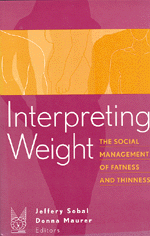

![]()
Weighty Issues: Fatness and Thinness as Social ProblemsJeffery Sobal and Donna MaurerAldine de Gruyter: New York 1999 0202305805 (pb) 260 pp.
|
Interpreting Weight: The Social Management of Fatness and ThinnessJeffery Sobal and Donna MaurerAldine de Gruyter: New York 1999 0202305783 (pb) 264 pp.
|


"Interpreting Weight" fulfils its aim of demonstrating the centrality of body weight in everyday life. The broad scope of the text incorporates comment on the relationship between weight and identity, charts shifting definitions and approaches to weight issues and analyses processes in organisations, which seek to control weight. Together these interests chart the meanings of fatness and thinness, and are concluded by Cogan's arguments for a paradigm shift away from a view that healthy means thin.
The accompanying text "Weighty Issues", delves further into the historical emergence of weight as a problem, including the analysis of medical models. Institutional components are discussed, with analysis of the meanings of weight held by dieticians and nutritionists. Further, the meanings of weight and body size are investigated in social movements. This includes the vegetarian movement's rejection of the notion that 'vegetarian means too skinny' and the size acceptance movements framing of obesity as a political issue, in contrast with past discourses which have viewed obesity in medical and moral terms.
"Weighty Issues" also devotes space to the consideration of the gendered aspects of weight issues. McKinley charts the multiple and contradictory constructions of the 'ideal woman' and argues that 'ideal weight' is essential and indispensable to this notion. Germov and Williams adopt Foucault's notion of the body panoptican, emphasising women's complicity in the 'thin ideal', through surveillance of themselves and other women's body size. McCaughey's contribution highlights the ideal body types for men and questions whether bodybuilding for men and anorexia for women, really have gender conformity as their goal. In "Interpreting Weight" the investigation of the management of overweight identities also highlights the gendered dimensions of weight. Chapman, for example, charts the shift from strict short-term 'fad' diets, to an emphasis on 'healthy eating', noting that both emphasise self-regulation and self-monitoring. Both are seen to lead to women feel of incompetent and failures.
Contributions, such as that by Cordell and Ronai, celebrate womens' resistance of the 'thin ideal'. However, other contributions (for example, McKinley) suggest that to effectively change all women's discontent with their weight, will require a challenge to existing power structures. This highlights a conclusion present underneath the surface of these texts which could have been made clearer, that is it is not only women who are constructed as too fat or too thin who are repressed by this stigma, but all women. A consideration of this would also further clarify what the editors mean by classifying weight as a social problem, and what the dimensions of this problem are i.e. who is it a problem for? The lack of agreement among these contributions about the way forward for women, who want to reject the image of the ideal woman as a thin woman, highlights the gendered dimensions of weight as an area in need of further research, analysis and comment.
These complementary texts, contribute towards a shift from medical and psychological explanations of 'weight problems', which have largely failed to challenge the perception that 'thin' is ideal and that 'fat' is bad. Sobal and Maurer's contribution to a development of a sociological understanding of weight, is not only an important contribution to sociology, but also for those who have ever felt the pressure to conform to the 'thin ideal' and have gone on a diet or tried to 'eat healthily' to lose weight. It also succeeds by linking the problem of thinness and conditions such as anorexia, to the problem of obesity, within the context of a sociological understanding of the construction of body size. Both texts are recommended to anyone interested in an introduction to weight issues.
Catherine Walker
Sheffield University
